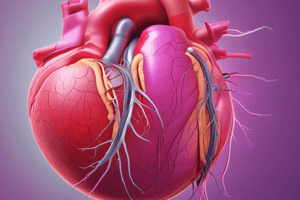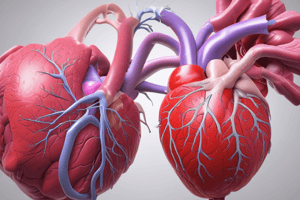Podcast
Questions and Answers
What is the normal range of thickness for the left ventricle wall?
What is the normal range of thickness for the left ventricle wall?
- 1.0-1.2 cm
- 1.5-1.8 cm
- 0.3-0.5 cm (correct)
- 0.8-1.0 cm
Which artery supplies the posterior aspect of the right ventricle?
Which artery supplies the posterior aspect of the right ventricle?
- Anterior descending branch
- Left coronary artery
- Circumflex branch
- Right coronary artery (correct)
Which primary tumor is most commonly found in adults and located in the atrium?
Which primary tumor is most commonly found in adults and located in the atrium?
- Lung carcinoma
- Rhabdomyoma
- Myxoma (correct)
- Leukemia and lymphomas
Which primary tumor is associated with infants and children and often shows spontaneous regression?
Which primary tumor is associated with infants and children and often shows spontaneous regression?
Which type of pericarditis is often caused by myocardial infarction or uremia?
Which type of pericarditis is often caused by myocardial infarction or uremia?
What characterizes purulent or suppurative pericarditis?
What characterizes purulent or suppurative pericarditis?
What mainly causes hemorrhagic pericarditis?
What mainly causes hemorrhagic pericarditis?
What is the main cause of caseous pericarditis?
What is the main cause of caseous pericarditis?
What follows suppurative or caseous pericarditis, previous cardiac surgery, or radiation?
What follows suppurative or caseous pericarditis, previous cardiac surgery, or radiation?
What results in limitation in diastolic expansion and restriction in cardiac output?
What results in limitation in diastolic expansion and restriction in cardiac output?
What can result from the Frank-Starling mechanism and myocardial adaptations?
What can result from the Frank-Starling mechanism and myocardial adaptations?
What commonly causes left-sided heart failure?
What commonly causes left-sided heart failure?
What often causes right-sided heart failure?
What often causes right-sided heart failure?
What are lipomas usually characterized by?
What are lipomas usually characterized by?
Where are papillary fibroelastomas localized?
Where are papillary fibroelastomas localized?
What is the normal weight range of a male heart?
What is the normal weight range of a male heart?
Which artery supplies the lateral wall of the left ventricle?
Which artery supplies the lateral wall of the left ventricle?
Which primary tumor is associated with smooth muscle cells and/or fibroblastic cells?
Which primary tumor is associated with smooth muscle cells and/or fibroblastic cells?
What is the normal range of thickness for the right ventricle wall?
What is the normal range of thickness for the right ventricle wall?
Which type of pericarditis is mainly composed of blood and may be caused by tuberculosis or malignant neoplastic involvement?
Which type of pericarditis is mainly composed of blood and may be caused by tuberculosis or malignant neoplastic involvement?
What results in limitation in diastolic expansion and restriction in cardiac output?
What results in limitation in diastolic expansion and restriction in cardiac output?
What characterizes purulent or suppurative pericarditis?
What characterizes purulent or suppurative pericarditis?
What follows suppurative or caseous pericarditis, previous cardiac surgery, or radiation?
What follows suppurative or caseous pericarditis, previous cardiac surgery, or radiation?
What can result from the Frank-Starling mechanism and myocardial adaptations?
What can result from the Frank-Starling mechanism and myocardial adaptations?
What is the main cause of caseous pericarditis?
What is the main cause of caseous pericarditis?
Where are lipomas usually localized?
Where are lipomas usually localized?
What does left sided heart failure lead to
What does left sided heart failure lead to
What is the main cause of right-sided heart failure?
What is the main cause of right-sided heart failure?
What artery supplies the lateral wall of the left ventricle?
What artery supplies the lateral wall of the left ventricle?
What artery supplies the posterior aspect of the right ventricle?
What artery supplies the posterior aspect of the right ventricle?
What is the normal range of thickness for the left ventricle wall?
What is the normal range of thickness for the left ventricle wall?
Flashcards are hidden until you start studying
Study Notes
Pericarditis and Cardiomyopathy Overview
- Lipomas are usually asymptomatic and do not cause obstructions
- Papillary fibroelastomas are localized on heart valves
- Causes of pericarditis include infections, immun-mediated reactions, and other factors like neoplasia and trauma
- Pericarditis can be classified according to clinicopathologic findings, inflammatory changes, and fluid accumulation
- Fibrinous/serofibrinous pericarditis is the most frequent type, often caused by myocardial infarction or uremia
- Purulent or suppurative pericarditis is characterized by invasion of infective organisms and thin creamy pus
- Hemorrhagic pericarditis is mainly composed of blood and may be caused by tuberculosis or malignant neoplastic involvement
- Caseous pericarditis is rare and mainly caused by tuberculosis
- Adhesive mediastinopericarditis follows suppurative or caseous pericarditis, previous cardiac surgery, or radiation
- Constrictive pericarditis results in limitation in diastolic expansion and restriction in cardiac output
- Heart failure can result from several physiologic mechanisms, including the Frank-Starling mechanism and myocardial adaptations
- Left sided heart failure is commonly caused by ischemic heart disease, hypertension, and valvular diseases, leading to pulmonary congestion and edema, while right sided heart failure is often caused by left-sided heart failure and presents with peripheral congestion and edema
Pericarditis and Cardiomyopathy Overview
- Lipomas are usually asymptomatic and do not cause obstructions
- Papillary fibroelastomas are localized on heart valves
- Causes of pericarditis include infections, immun-mediated reactions, and other factors like neoplasia and trauma
- Pericarditis can be classified according to clinicopathologic findings, inflammatory changes, and fluid accumulation
- Fibrinous/serofibrinous pericarditis is the most frequent type, often caused by myocardial infarction or uremia
- Purulent or suppurative pericarditis is characterized by invasion of infective organisms and thin creamy pus
- Hemorrhagic pericarditis is mainly composed of blood and may be caused by tuberculosis or malignant neoplastic involvement
- Caseous pericarditis is rare and mainly caused by tuberculosis
- Adhesive mediastinopericarditis follows suppurative or caseous pericarditis, previous cardiac surgery, or radiation
- Constrictive pericarditis results in limitation in diastolic expansion and restriction in cardiac output
- Heart failure can result from several physiologic mechanisms, including the Frank-Starling mechanism and myocardial adaptations
- Left sided heart failure is commonly caused by ischemic heart disease, hypertension, and valvular diseases, leading to pulmonary congestion and edema, while right sided heart failure is often caused by left-sided heart failure and presents with peripheral congestion and edema
Studying That Suits You
Use AI to generate personalized quizzes and flashcards to suit your learning preferences.



